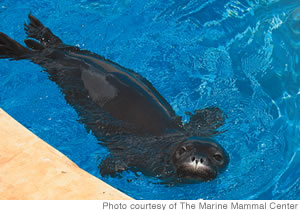Cautious Optimism For Monk Seals

Wednesday - July 09, 2008
| Share
 Del.icio.us
Del.icio.us
|
They have been near the top of the endangered species list for many years, clinging to existence - one pup at a time. But the Hawaiian monk seal has found a way to survive in the brutally challenging and ever-changing ocean environment.
“This species is so endangered every single one is important for the survival of the population,” says David Schofield, marine mammal response coordinator of the National Oceanic Atmospheric Administration Fisheries Pacific Island Region.
The fragile population recently received a new title, thanks to a new law. The Hawaiian monk seal is now the official state mammal. Scientists believe the new distinction propels the animal to the status of the humpback whale.
“As the state mammal it will help us with our awareness campaign,” says Schofield. “It will engage children and it will hopefully identify funding at private, state and agency levels.”
Schofield says such funding will give the monk seal a better chance to thrive, especially in Hawaiian waters. The population is currently estimated at 1,200.
“While the population on the whole is declining at 4 percent per year, here in the main Hawaiian Islands the monk seals seem to be doing really well,” says Schofield. “They’re fat, the moms are really big, they give birth to big pups and they stay with their pups for a long period of time.”
But that was not the case in early May, when a seal pup born on Kauai was attacked by its mother and then abandoned. The U.S. Coast Guard sent an emergency airlift to Kauai and the pup was delivered to a marine facility at Kewalo Basin. A team from NOAA immediately stepped in and started caring for the young pup, working around the clock to keep it alive.
The pup is believed to be the first newborn monk seal to be rescued and taken into captivity. At the time of the rescue, doctors thought the pup had a 50 percent chance of survival. Two months later, the pup, which is now labeled as “KP2,” is eating, gaining weight and thriving.
“It appears the attempt to raise the caloric value in his food has paid off as the pup now weighs in at 55 pounds (up from 33 pounds),” says Wende Goo, NOAA Fisheries spokesperson. “KP2 continues to appear bright and active, and is tolerant of his feeding regimen. Another indication the pup is growing is he has begun to show his first few teeth.”
Goo says although this is positive news, NOAA remains cautiously optimistic because KP2 is still not out of the woods. If the pup survives, it will add to what’s already been a remarkable year of progress for the species.
“We’ve had a banner year for pupping events here in the main Hawaiian Islands, up to 12 pups so far this year,” Schofield says proudly. “It’s all about awareness; it’s all about capacity building. We’ve got to understand that we’ve got to coexist with these Hawaiian monk seals. They were here first and so we have to learn to live with them.”
And there are still two expectant mothers swimming around the Big Island and Oahu. Marine scientists say, as a whole, Hawaii, is doing its part to spread the word. The new title solidifies the state’s commitment.
“We’ve got more volunteers on Hawaii beaches than ever before,” says Schofield. “The seals need the beach. As much as we like to recreate on the beach, they actually need it as part of their life history.”
It’s our job to make sure they’re still a part of our history.
E-mail this story | Print this page | Comments (0) | Archive | RSS Comments (0) |
Most Recent Comment(s):













